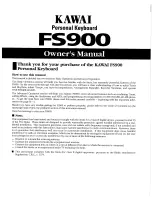
10-74
KDFX Reference
KDFX Algorithm Specifications
Parameters for Two-effect Routing
Page 1
Mix Effect
Adjusts the amount of each effect that is mixed together as the algorithm wet signal.
Negative values polarity invert that particular signal.
A/Dry->B
This parameter controls how much of the A effect is mixed with dry and fed into the B
effect. A and B are designated in the algorithm name. This control functions like a wet/
dry mix, where 0% is completely dry and 100% is effect A only.
Signal Routing (3 effects)
The algorithms listed above with 3 effects allow serial or parallel routing between any two effects. Effects
A, B, and C are designated respectively by their order in the algorithm name. Effect A is wired to the input
of effect B and C, and effect B is wired into effect C. The input of effect B is a mix between effect A and the
algorithm dry input. The input into effect C is a three-way mix between effect A, effect B, and the dry
signal.
Like in the 2 effect routing, the input of effect B is controlled by a parameter A/Dry>B. where A is effect A,
and B is effect B. For example, in Chor+Dly+Rvb, the parameter name is “Ch/Dry>Dly”.
The input into effect C is controlled by 2 parameters named A/B ->* and */Dry->C where A, B, and C
correspond to the names of effects A, B, and C. The
fi
rst parameter mixes effect A and B into a temporary
buffer represented by the symbol “*”. The second parameter mixes this temporary buffer “*” with the dry
signal to be fed into effect C. These mixing controls function similarly to Wet/Dry parameters. A setting of
0% only mixes the denominator, while 100% only mixes the numerator. Negative values polarity invert the
signal associated with the numerator.
Effects A, B, and C outputs are mixed at the algorithm output to become the wet signal. Separate mixing
levels are provided for left and right channels, and are named “L Mix” or “R Mix”. Negative mix amounts
polarity invert the signal which can change the character of each effect when mixed together or with the
dry signal. The Wet/Dry parameter adjusts the balance between the sum of all effects determined by the
Mix parameters, and the input dry signal. Negative Wet/Dry values polarity invert the summed wet
signal relative to dry.
Parameters for Three-effect Routing
Page 1
Wet/Dry
-100 to 100 %
Out Gain
Off; -79.0 to 24.0 dB
Mix Effect
-100 to 100 %
Mix Effect
-100 to 100 %
A/Dry->B
0 to 100%
Wet/Dry
-100 to 100 %
Out Gain
Off; -79.0 to 24.0 dB
L Mix Effect A
-100 to 100 %
R Mix Effect A
-100 to 100 %
L Mix Effect B
-100 to 100 %
R Mix Effect B
-100 to 100 %
L Mix Effect C
-100 to 100 %
R Mix Effect C
-100 to 100 %
Summary of Contents for K2661
Page 18: ...2 4 LFOs LFO Shapes...
Page 34: ...3 16 DSP Algorithms...
Page 54: ...5 4 MIDI Note Numbers Note Numbers for Percussion Keymaps...
Page 72: ...7 10 System Exclusive Protocol K2661 System Exclusive Implementation...
Page 82: ...9 4 Upgrading Sample Memory Choosing and Installing a SIMM for K2661 Sample Memory...
Page 334: ...10 252 KDFX Reference KDFX Algorithm Specifications...
Page 340: ...11 6 Glossary...
Page 382: ...12 42 Triple Modular Processing Alphanumeric Buttonpad Entries for DSP Functions...
Page 392: ...B 6 SysEx Control of KDFX MSB and LSB...
Page 442: ...D 20 Contemporary ROM Block Objects Controller Assignments Contemporary ROM Block...
Page 490: ...H 12 General MIDI Standard Mode Controller Assignments...
Page 492: ...I 2 Live Mode Objects Live Mode Programs...
Page 498: ...K2661 Musician s Reference Index...
Page 500: ......
















































